Miller Nichols Library, University of Missouri-Kansas City
Introduction
Text-to-speech Audio
Dedicated in 1969 as a three-story structure known as the General Library, UMKC's Miller Nichols Library has grown thanks to the support of area philanthropists to include more individual and collaborative spaces for students, resources for faculty, and several unique archival collections that serve scholars and the Kansas City community. The library was named in honor of Miller Nichols in 1991 following a $1.5 million donation that supported the completion of the fourth floor.
Images
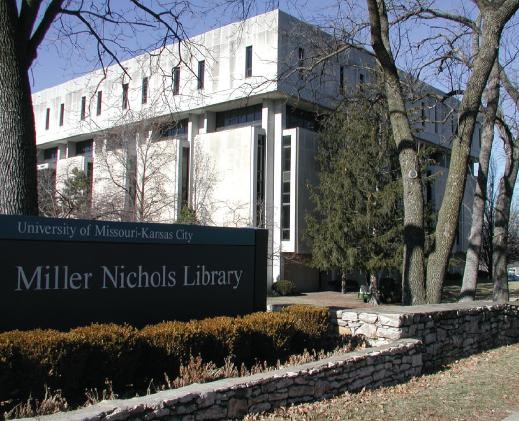
Miller Nichols Library Learning Center
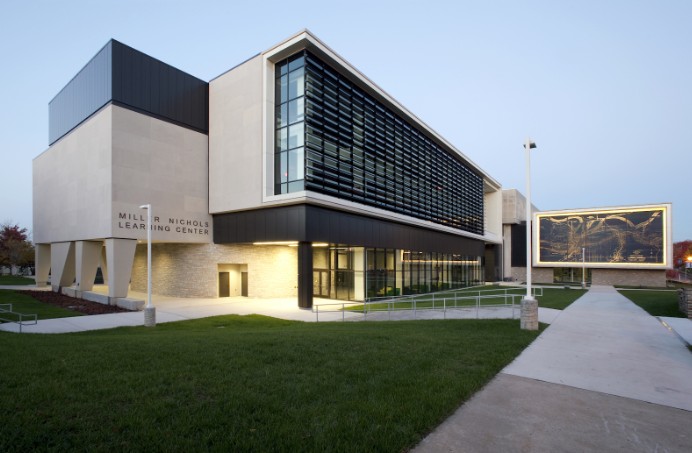
The exterior of the library's automated retrieval system displays a map of Kansas City that is illuminated at night.
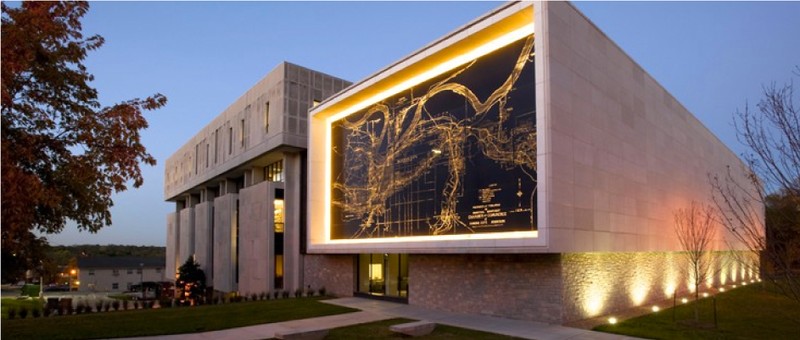
The UMKC General Library circa 1970. Notice the campus pond in the lower left.
%20The%20bridge%20over%20the%20sunken%20courtyard%20design%20won%20an%20award.%20Campus%20pond%20visible%20in%20the%20lower%20left%20where%20Plaster%20center%20is%20today..jpg)
View of the original UMKC General Library Entrance
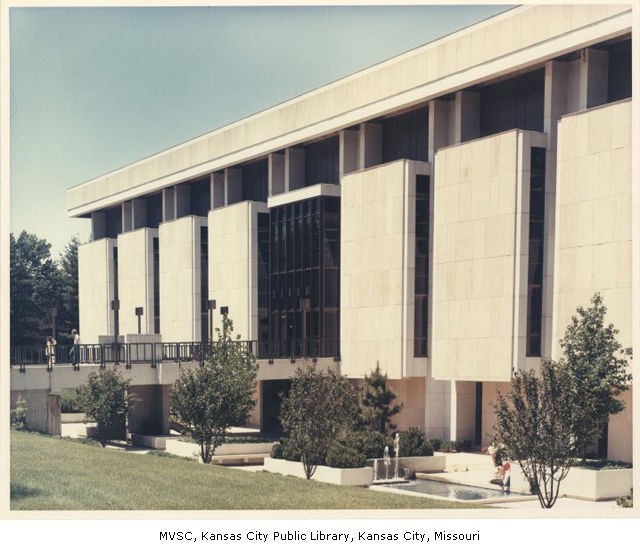
Bookplate from the original University of Kansas City Library
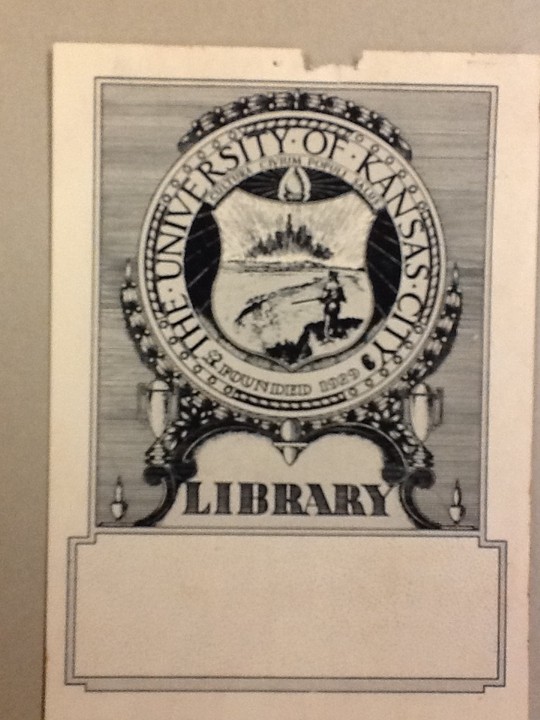
Miller Nichols Learning Center construction 2012
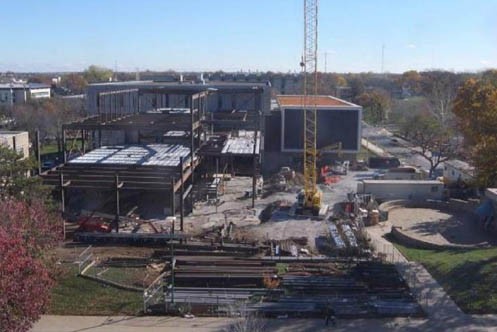
General Library 4th Floor expansion 1991
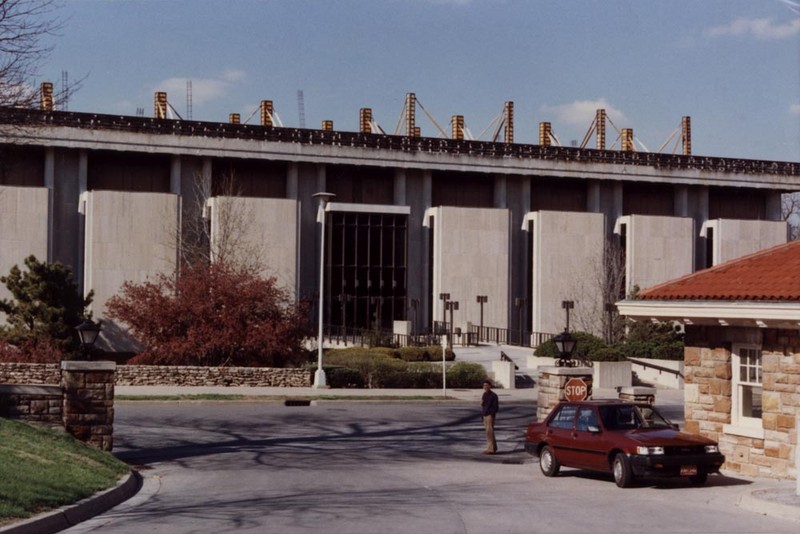
Miller Nichols Portrait from 1st floor library entrance
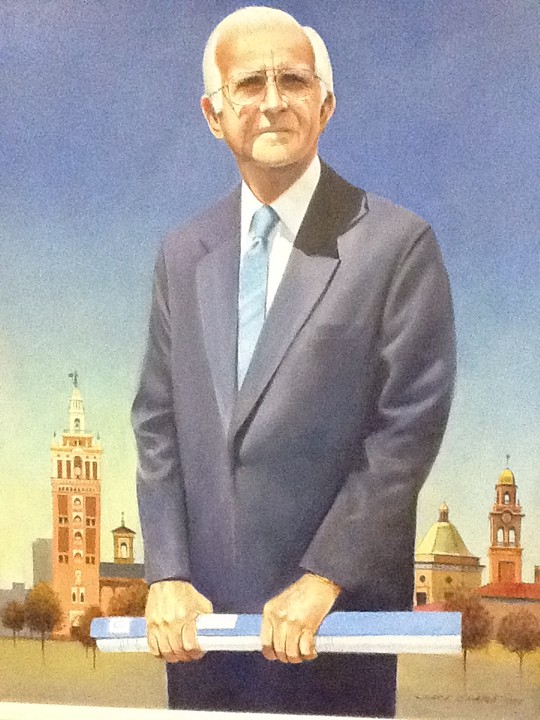
Prima Vera by former UMKC Professor Eric Bransby is one of numerous art pieces displayed in the Miller Nichols Library
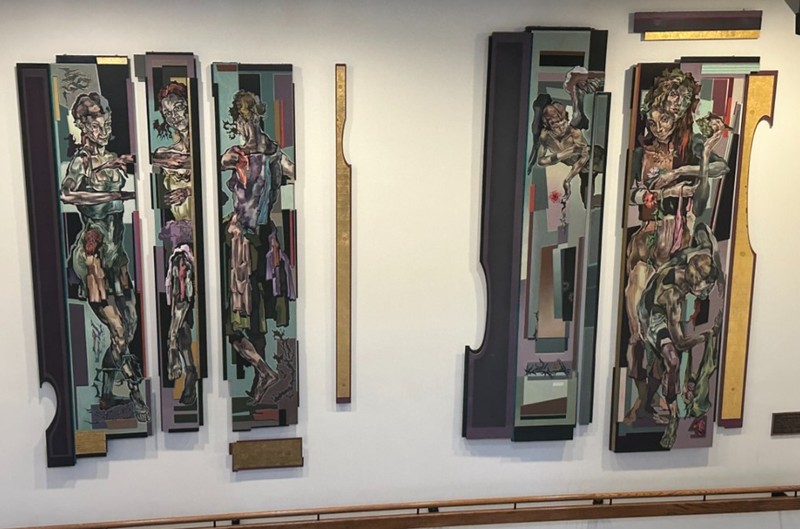
Kansas City Research Center is located on the third floor of the Miller Nichols Library
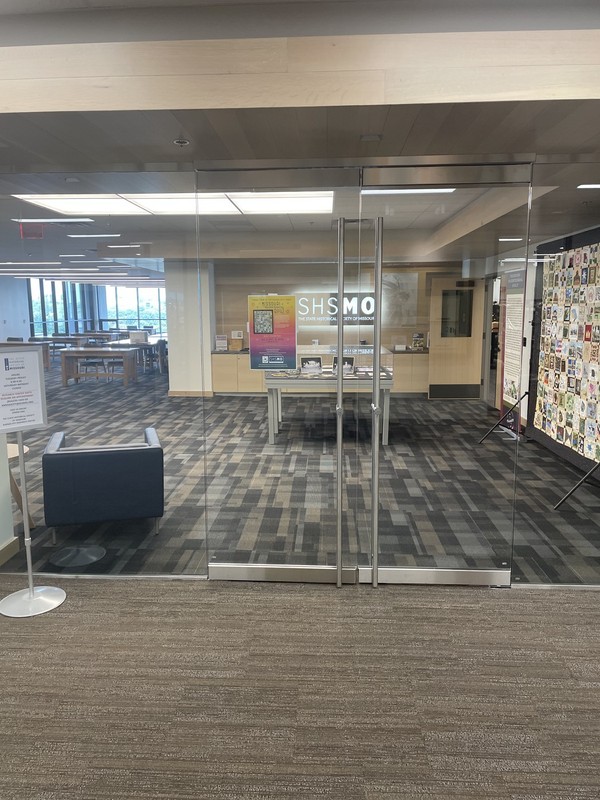
Richard L. Sutton Jr. Geosciences Museum
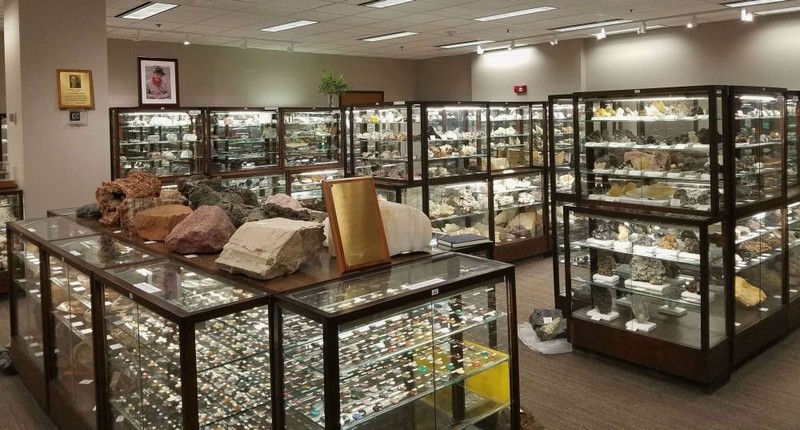
The Starr Women's Hall of Fame is on the Third Floor of UMKC's Miller-Nichols Library

A photo of Martha Jane Starr and Hillary Clinton at the Women's Conference Circle on January 24, 1996
.jpg)
LaBudde Special Collections holds archival materials from individuals and organizations and the University Archives.
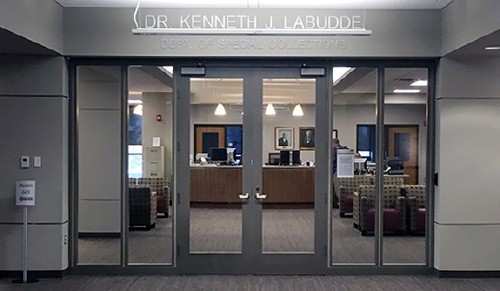
Digital Collaboration Studio

Marr Sound Archives is located on the ground floor of UMKC's Miller Nichols Library
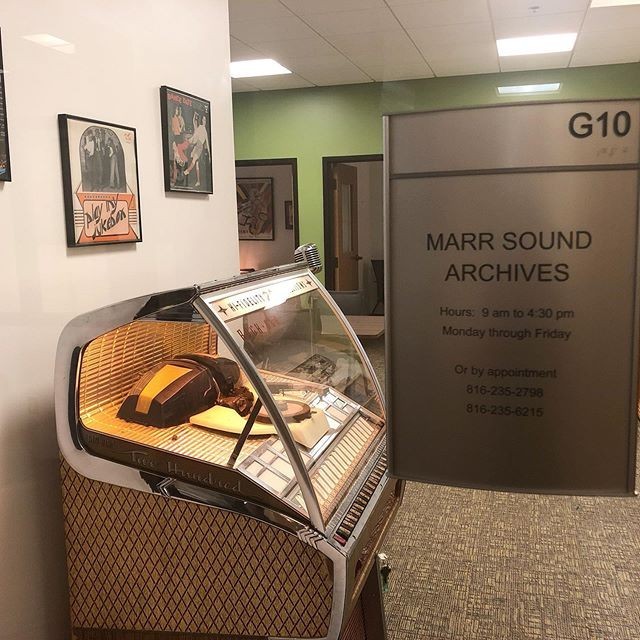
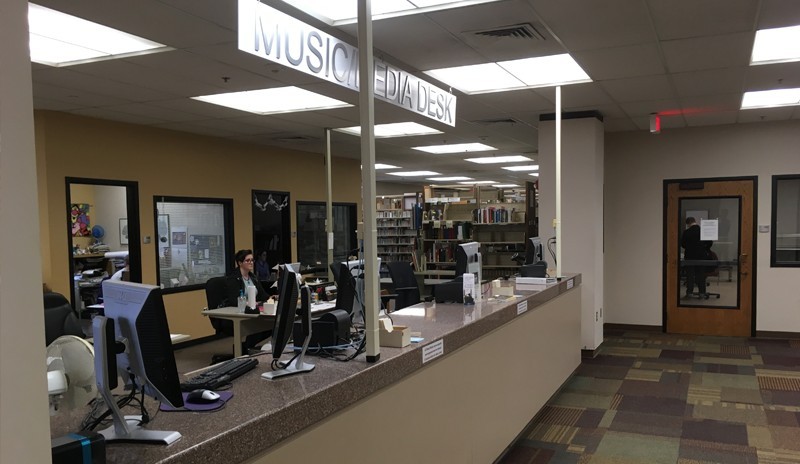
Backstory and Context
Text-to-speech Audio
Believing in the civic value of higher education, William Volker and other Kansas City philanthropists began the effort to create Kansas City University in the 1920s. The university opened in the midst of the Great Depression with the former Dickey Mansion at 5100 Rockhill at the sole building. The first library occupied what was originally the home's living room. Thanks to a donation from Volker, the first university library, today known at Newcomb Hall, opened in 1936 under the direction of head librarian Marjorie Copeland.
The fifth library director, Dr. Kenneth Labudde, was a historian who believed that a library was the core of a university. Under his leadership which began in 1950, the university worked to increase library holdings and also raised funds to build this modern structure with the support of area philanthropists. After the University of Kansas City merged with the University of Missouri System in 1963, enrollment at UMKC began to grow rapidly. The student population increased from less than 4000 in 1963 to nearly 10,000 by 1969. However, the original campus library had been built for a student population of 1000. Library books were stored off site and students often had to wait days to receive requested materials and there was only study space for 150 students.
Through a combination of private fundraising and money appropriated by the state legislature, the university was able to construct the General Library in 1969. The three-story structure was designed with an eventual addition of a fourth floor in mind. The entrance to the library was a bridge over a sunken courtyard of gardens and fountains. The General Library allowed the university to bring together its entire collection of Social Sciences and Humanities books for the first time. Moreover, it provide the study space necessary for the university's rapidly growing student population. By the late 1980s, the library collection had already outgrown the general library and the university decided to build a fourth floor on the building. Long time UMKC patron and advocate Miller Nichols donated $1.5 million to the project. The university showed its appreciation by renaming the building the Miller Nichols Library.
In the early 2000s, the library once again needed to create more space for students and modern amenities such as a cafe. The university built a robotic retrieval system between 2008 and 2010 that freed up space for study areas. The system allows for compact storage of books and other materials and has been affectionately given the nickname "Roobot" by UMKC students as a nod to the university's mascot. The addition of the Miller Nichols Learning Center was completed in 2013, resulting in the creation of a new entrance and the addition of classrooms and a lecture hall.
The most recent renovation was completed in 2021 thanks to the Sunderland Foundation and William T. Kemper Foundation, facilitating the relocation of the Missouri Historical Society Center from Newcomb Hall to the third floor and the creation of the Digital Collaboration Studio.
Music/Media Library and Marr Sound Archives
Located on the ground floor of UMKC's Miller Nichols Library, the Music/Media library offers a collection of books, magazines, and journals related to music along with over 130,000 music scores and audio recordings on media from CDs and records to digitized recordings available online. The collection also includes a variety of photos, manuscripts, and video recordings.
Established in 1986 with a gift from UMKC Associate Professor Gaylord Marr and his wife Olga Marr, this unique library has grown from Marr's initial collection of 42,000 sound recordings to a collection ten times that size that is utilized by researchers around the globe. The archive is known nationally for its jazz collection and its extensive repository of classical music, and its collection includes numerous recordings of the spoken word and nearly every genre of music. The sound archive includes a preservation lab with technicians who work daily to restore everything from wax cylinders and records to cassettes and digital recordings. The archive has been a leader in the field of audio preservation for the past three decades and offers a variety of ways for students and faculty to learn about the preservation process.
Kansas City Research Center, State Historical Society of Missouri
The Kansas City Research Center of the State Historical Society of Missouri has been located on the UMKC campus since 1980. Formerly located in Newcomb Hall, this public archive of Missouri history was moved to the third floor of Miller Nichols Library as part of a larger remodel of the library in 2021. The archive holds over 13,000 cubic feet of records in the libraries innovative "Roobot" retrieval system, and also offers access to the archival holding of each of the archives in the University of Missouri system and the State Historical Society. Created in 1943 by the members of the University of Missouri system, the Western Historical Manuscript Collection is a system of history archives that preserve and share state and regional history. Guests at this archive can view and request archival records from other campuses and they will be delivered to the UMKC library for their use.
Richard L. Sutton Jr. Geosciences Museum
This small museum dates back to 1973 when UMKC professor and dean Eldon J. Parizek worked with Richard Sutton, a leader in the field of dermatology and adjunct professor of geosciences, to offer exhibits drawn largely from Sutton's personal collection of specimens. Highlights of the collection include numerous crinoids, a large fulgurite that was formed by a lightning strike, and items from Sutton's personal collection which includes cephalopods and rocks containing trapped liquid from tens of thousands of years ago. Thanks to Professor Emeritus Richard Gentile and his students at UMKC over the past four decades, the museum collection has grown to include numerous specimens from vertebrate fossils collected during dozens of research trips throughout the United States. The museum began with the personal collection of Dr. Richard Lightburn Sutton Jr. in 1973, and has grown to include new specimens thanks to the cadre of museum curators that followed over the next half-century. In addition to Dr. Gentile, the museum is curated by Dr. James Murowchick and Dr. Raymond Coveney.
LaBudde Special Collections
Dedicated in 2002 and named in honor of the late Dr. Kenneth J. LaBudde, this research center on the third floor of UMKC's Miller Nichols Library combines a research center, archive, and rare book collection. Materials in the collection are utilized by students, local historians, and scholars from around the globe who share interests in the collection many strengths which include music history and Kansas City jazz, women's and gender history, rare books related to Kansas and Missouri, and manuscript collections related to regional history. LaBudde Special Collections offers a variety of online and digital exhibits and it also serves as the home of the Gay and Lesbian Archive of Mid-America. Special Collections also houses the university archives, a repository of materials related to the history of the UMKC. Dr. LaBudde was a professor of history and served as the Director of UMKC Libraries from 1950 to 1985.
Similar to other university special collections departments, LaBudde's stacks are closed and researchers request archival materials by working with archivists and staff at the service desk. Thanks in part to the support of local foundations and the National Endowment for the Humanities, LaBudde Special Collections was recently renovated to offer more space for researchers as well as students and classes that utilize the library.
Digital Collaboration Studio
Completed in 2021 thanks to the generosity of the Sunderland Foundation and the William T. Kemper Foundation, the Digital Collaboration Studio offers a variety of spaces and tools designed to support students and faculty at UMKC. The large seminar room offers seating for 12 with video conferencing capability and a digital whiteboard. There are also two small collaboration rooms with high-definition monitors. The center of the studio offers tables and monitors designed to facilitate small group collaboration around monitors, and there is also a recording studio and production room to support oral histories and other public and digital humanities projects.Each of the four screens in the center of the space can be set to display the same content or allow each cluster to connect to a different source to facilitate group projects with the support of an instructor who can move around the room. This space on the third floor of Miller Nichols Library is open to UMKC students and faculty during regular library hours. Students and faculty can also reserve the small collaboration rooms and seminar rooms.
Starr Women's Hall of Fame
In recognition of the extraordinary life and contributions of Martha Jane Starr and many other women in Kansas City, the University of Missouri-Kansas City created the Starr Women's Hall of Fame in 2015. The third floor of the Miller Nichols Library includes a gallery that honors inductees and shares the history of the diverse women who have made a significant impact in Kansas City and beyond. The Hall's namesake, Martha Jane Starr, was a woman with a passion for education, advocacy for women, and helping the community as demonstrated by her support of numerous volunteer organizations. Among Starr's contributions are leadership in founding the Women's Council at the University of Missouri-Kanas City as well as the Graduate Assistance Fund for women in higher education. Her passion for promoting education on reproduction and support for programs that strengthen familial relationships and marriage allowed her and her programs to help families and couples in the area.
Martha Jane Starr was born Martha Jane Phillips on November 27, 1906, in Bartlesville, Oklahoma. Martha was born into a privileged family, with her father, L.E. Phillips, being one of the co-founders of the Phillips Petroleum Company. She attended Bartlesville High School, where she was a member of the National Honor Society and the State Honor Society. Martha graduated from high school in 1925. While her family upbringing offered her special advantages, such as world travels, she was not permitted the chance to attend University. Although her brothers received a university education, Martha attended the Erskine School for Girls, a finishing school in Boston, Massachusetts, from 1925 until 1927. Although she was not allowed the chance to receive a higher education, this would not hinder Martha from achieving her goals and helping those throughout the community.
In 1929, Martha married John “Twink” Starr, who had been working for L.E. Phillips as a geologist in his petroleum company. The couple would move to Kansas City in 1932, where both Martha’s and John’s contributions to the community began. Martha entered the Kansas City Junior League the same year she moved to the city and would be a member in various positions for decades. When World War II broke out, John was called to military service, while Martha was called to community service. She served at the Red Cross Blood Center from 1942 to 1944 and served as the Chairman of the Red Cross Nurse’s Aid Program from 1944 to 1946. After the War ended, John returned to Kansas City, and both Starrs continued to contribute to Kansas City throughout their lives.
Martha would move onto a wide array of public work through various volunteer organizations and community affiliations. One such organization, which was especially progressive for the time, was Planned Parenthood, which Martha began working with in 1947. Through her work with Planned Parenthood, whom she would work with for years and serve as a board member and president, she focused on biological aspects of reproduction. This focus, which was not a common research topic within the medical community at the time, would lead to the creation of the first Research Professorship in Human Reproduction, held at the University of Kansas Medical Center. While rallying the funds for this professorship was difficult, it would be successful. However, Martha would not end her quest for educating the community on reproduction and relationships with her time at Planned Parenthood. In fact, her work was only just beginning.
Martha held the importance of family and marriage in high regard, and believed that marriage should be a partnership of equality between spouses. She wanted to provide education for such an interpersonal relationship, especially with the prevalence of military marriages after World War II and the subsequent challenges they were facing. Her passion for this topic led her to Dr. David Mace, who was a sociology expert focusing on marriage enrichment. With his expertise, and the combined work of Martha and other individuals and organizations, the Research Center on Family Development was born in 1959. While this was an exciting feat in itself, it was difficult to gain public backing without a more credible institution in the mix. That led to a partnership with the University of Missouri-Kansas City in 1963. The University and Research Center merged together to form the Family Study Center. Although the Family Study Center closed in the 1990s, there were many programs that branched from the Center that are still in operation today, including the UMKC Women’s Center. While educating the public on family relationships was highly important to Martha, she was also passionate about women’s empowerment and development.
This work led Martha to yet another creation: the Women’s Council at the University of Missouri-Kansas City. She and a group of determined women formed the Women’s Council in 1967 to support women in the university system. Martha continued her work for women in the university system by creating the Graduate Assistance Fund. This fund provided scholarships for women who were in need. Not long after the creation of the Women’s Council, Martha was recognized for her enduring service to the community. In 1968, she was awarded the UMKC Chancellor’s Medal, making Martha the first woman to receive the award. Her participation in community organizations is innumerable, including affiliations with the Kansas City Council of Churches, the Greater Kansas City Mental Health Foundation Board, and the UMKC Board of Trustees. She would additionally provide donations and funds to multiple organizations and charities throughout her life.
Martha Jane Starr would pass away on November 14, 2011, at her home, after a lifetime of philanthropy and community advocacy. The Starr Women’s Hall of Fame, named after Martha Jane Starr, started in 2015 and is housed on the third floor of the Miller Nichols Library on the University of Missouri-Kanas City’s campus. It recognizes extraordinary women each year for their dedication to bettering the Kansas City area.
Sources
History of UMKC University Libraries, University Libraries, University of Missouri-Kansas City. Accessed November 16th 2021. https://libguides.library.umkc.edu/libraryhistory/MNL.
Homepage. Western Historical Manuscript Collection. Accessed August 27, 2024. https://www.umsystem.edu/ums/aa/units-manuscripts/#
About LaBudde Special Collections, University Libraries, University of Missouri-Kansas City. Accessed November 16th 2021. https://library.umkc.edu/labudde/about.
Geosciences Museum, Department of Earth and Environmental Sciences, University of Missouri- Kansas City. Accessed December 4th 2021. https://cas.umkc.edu/areas-of-study/earth-and-environmental-sciences/geosciences-museum.html.
About the Starr Women's Hall of Fame, Starr Women's Hall of Fame. Accessed November 7th 2021. https://www.umkc.edu/starrhalloffame/about.asp.
Hartzler, Elizabeth. Making Family Work: The Activism of Martha Jane Starr, UMKC Kansas City Activism. Accessed November 7th 2021. https://info.umkc.edu/kcactivism/?page_id=156.
MS-169, Box 1, Martha Jane Starr Starr Collection, LaBudde Special Collections, University of Missouri-Kansas City Libraries, Kansas City, MO.
Resume of Martha Jane Starr, MS-169, Box 1, Folder 1, Martha Jane Starr Collection, LaBudde Special Collections, University of Missouri-Kansas City Libraries, Kansas City, MO.
Stars of Kansas City Help Women Shine, UMKC Alumni Association. Accessed November 7th 2021. https://www.umkcalumni.com/s/1236/index2col.aspx?sid=1236&gid=1&pgid=1837.
Digital Collaboration Studio, University Libraries, University of Missouri-Kansas City. Accessed November 17th 2021. https://library.umkc.edu/digital-collaboration-studio.
https://info.umkc.edu/unews/miller-nichols-not-buying-any-books/
https://info.umkc.edu/unews/students-request-renaming-of-miller-nichols-library/
https://library.umkc.edu/giving
UMKC University Archives photo
Kansas City Public Library, Missouri Valley Collection
UMKC University Archives photo
Chris Wolff, UMKC Historian, collection
UMKC University Archives photo
Chris Wolff, UMKC Historian, collection
Chris Wolff, UMKC Historian, collection
Photo by David Trowbridge
LaBudde Special Collections, UMKC University Libraries, Martha Jane Starr Collection
